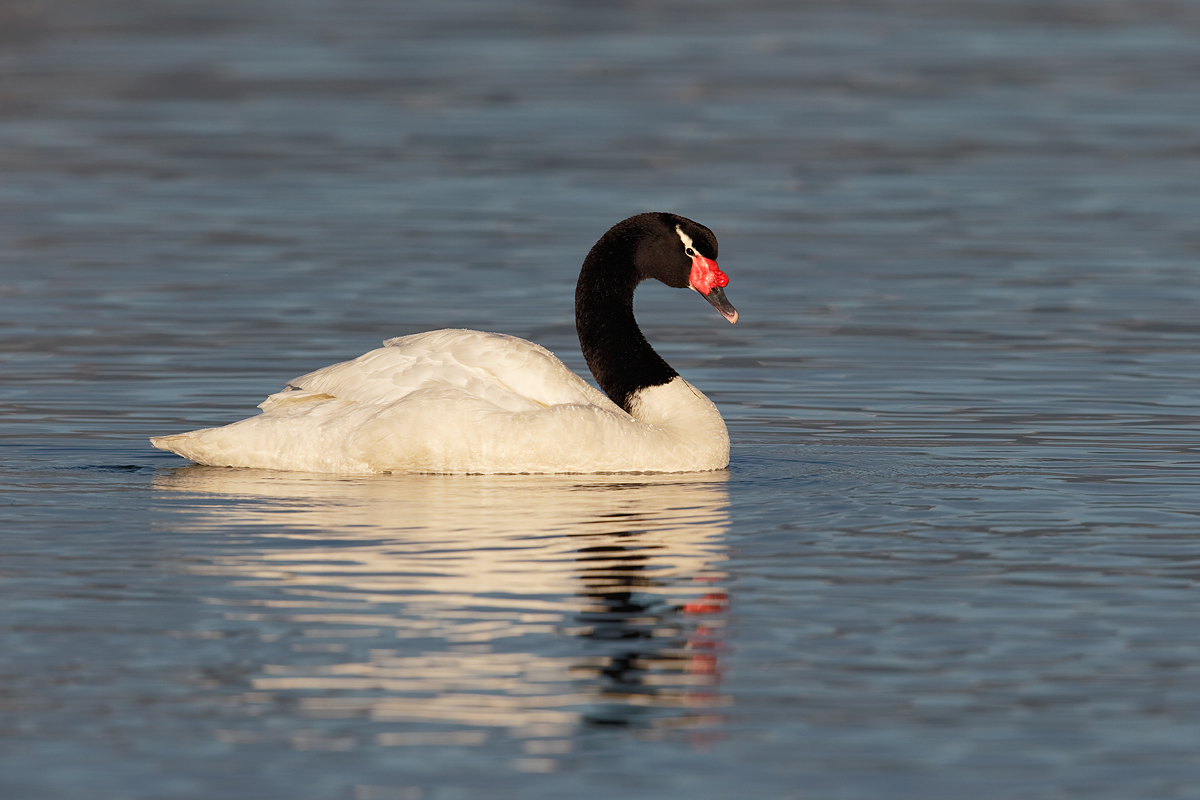
|
|
This Black-necked Swan was photographed in early morning light with the Gitzo 3532 LS carbon fiber tripod, the Mongoose M3.6 head–so good that we can’t keep them in stock; best to call Jim at 863-692-0906 and order yours so that you can one when we get a few, the Canon EF 600mm f/4L IS II USM lens, the Canon 1.4x EF Extender III (Teleconverter), and the Canon EOS-1D X. ISO 400. Evaluative metering at zero: 1/1000 sec. at f/8 in Manual mode. Central sensor AI Servo/Surround Rear Focus AF on spot where the black of the neck and the white of the upper breast meet active at the moment of exposure. Click on the image to see a larger version. |
First Blood Drawn Despite Bad Left Knee
Little more than a week ago I could not have imagined being able to walk a rock-strewn beach carrying my 600II on the Gitzo 3532 LS tripod. My twice surgically repaired left knee had been bothering me for nearly a month when I jumped out of bed while trying to nap about two weeks ago. I felt nothing. After I got back to sleep and woke, I could barely stand. The knee was swollen and the pain was fairly intense.
After my second arthroscopic surgery in 2006 or 2007, the surgeon said to me, “There is nothing left in the way of cartilage; I’ll see you in a year or two for a new knee.” The left knee had been fine till this most recent episode. Not being a huge fan of major surgery, I called Dr. Cliff Oliver in San Diego for guidance. Here’s what followed: Pete Egoscue Pain Free: A Revolutionary Method for Stopping Chronic Pain positions for knee pain, earth naps, Rock-taping, Active Release Therapy, mechanical thumper treatment, Tate Avacen treatment, rest, and ice baths (whole body in the tub for 35 minutes in 59 degree water).
While the knee is not yet fully heeled I was able to get around this morning quite comfortably. In short, the whole adventure with the knee has been somewhat miraculous. I just need to be careful and keep from wrecking it. 🙂
CRX-5 Low Foot/Plate
The CRX-5 Low Foot plate is ideal for all three of the Series II super-telephoto lenses. Learn why by clicking here. As it is also hard to keep this item in stock your best course of action is to call Jim at 863-692-0906 and order yours to ensure getting one from our next shipment.
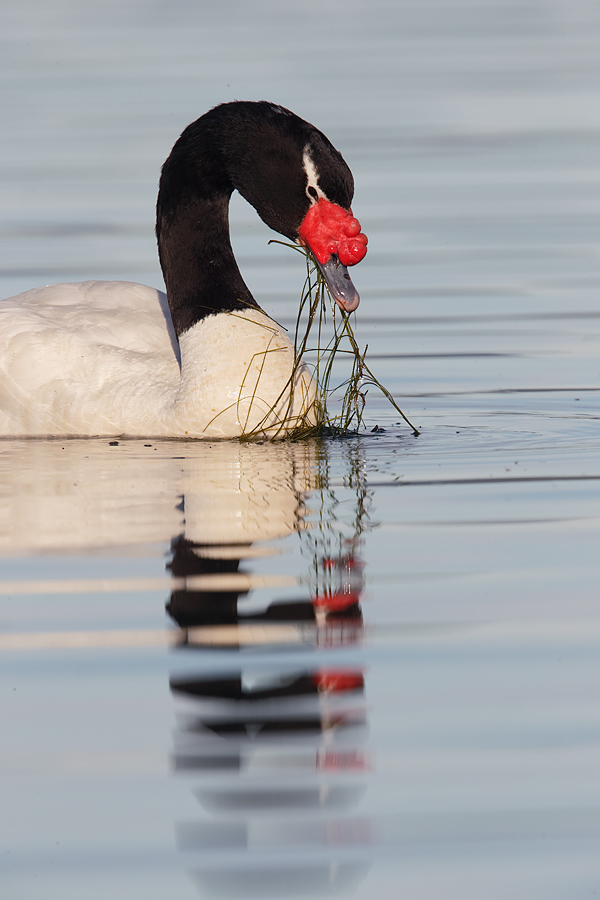
|
|
This feeding Black-necked Swan image was created with the Gitzo 3532 LS carbon fiber tripod, the Mongoose M3.6 head, the Canon EF 600mm f/4L IS II USM lens, the Canon 2x EF Extender III (Teleconverter), and the Canon EOS-1D X. ISO 400. Evaluative metering +1/3 stop: 1/500 sec. at f/13 in Manual mode. Central sensor (by necessity) Expand/AI Servo Rear Focus AF on the waterline just below the bird’s breast active at the moment of exposure. Click on the image to see a larger version. |
Up Early
After our long flights to Punta Arenas, Chile on Sunday evening red-eyes Denise Ippolito and I were picked up by a Remota Lodge van at about 5pm local time, one hour ahead of Florida and New Jersey. By 7:15pn we were at the lodge and were enjoying a fine fish dinner just before 8:00pm.
I woke early and seeing a calm sunny morning developing we walked down the hill to the water in hopes of photographing some birds. We were greeted by a pair of Black-necked Swans and photographed them for more than an hour.
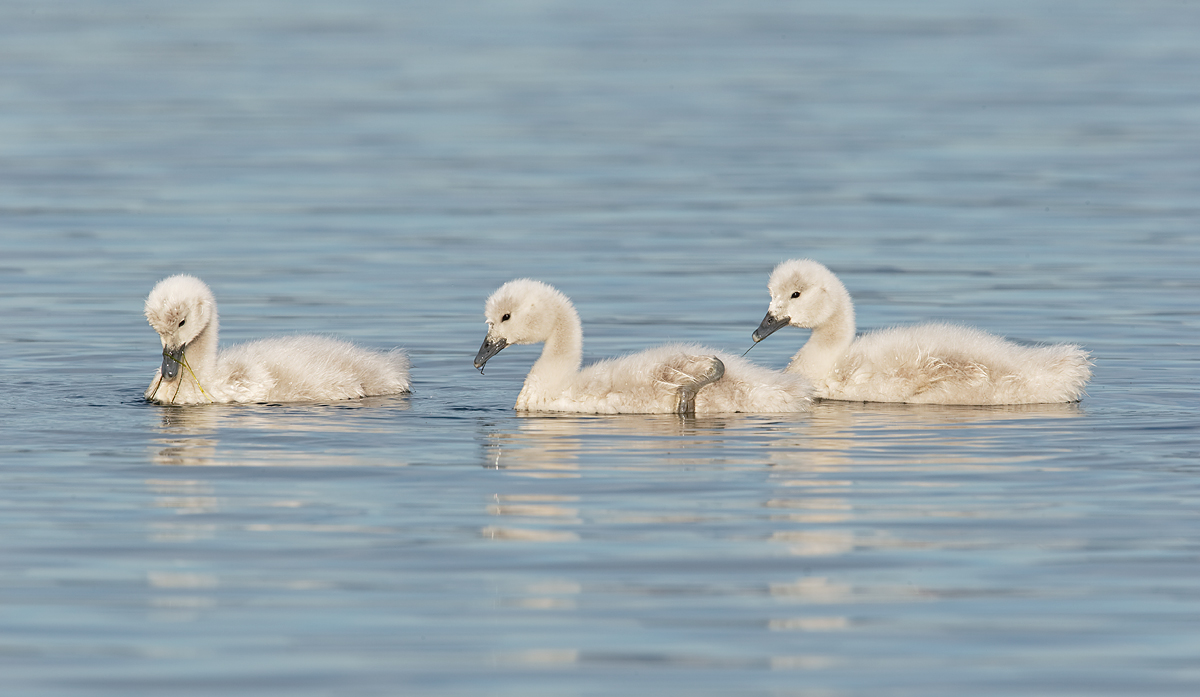
|
|
These Black-necked Swan cygnets were photographed this morning with the Gitzo 3532 LS carbon fiber tripod, the Mongoose M3.6 head, the Canon EF 600mm f/4L IS II USM lens, the Canon 2x EF Extender III (Teleconverter), and the Canon EOS-1D X. ISO 400. Evaluative metering +2/3 stop: 1/400 sec. at f/13 in Manual mode. Central sensor (by necessity) Expand/AI Servo Rear Focus AF on the body of the middle bird active at the moment of exposure. Click on the image to see a larger version. |
Continuing On
After a while, we decided to walk north a bit along the beach in search of some different species. Almost immediately I saw another pair of the handsome swans, this pair with four cygnets. We both were squealing with excitement. We stayed with the cygnets for well more than an hour. So much for variety being the spice of life….
Exposure Fine Point
Knowing that the exposure for the adult bird in image #2 was perfect, above, why did I add an additional 1/3 stop of light when photographing the very young swans? (1/400 sec. at f/13 for the cygnets as compared to 1/500 sec. at f/13 for the adults.)
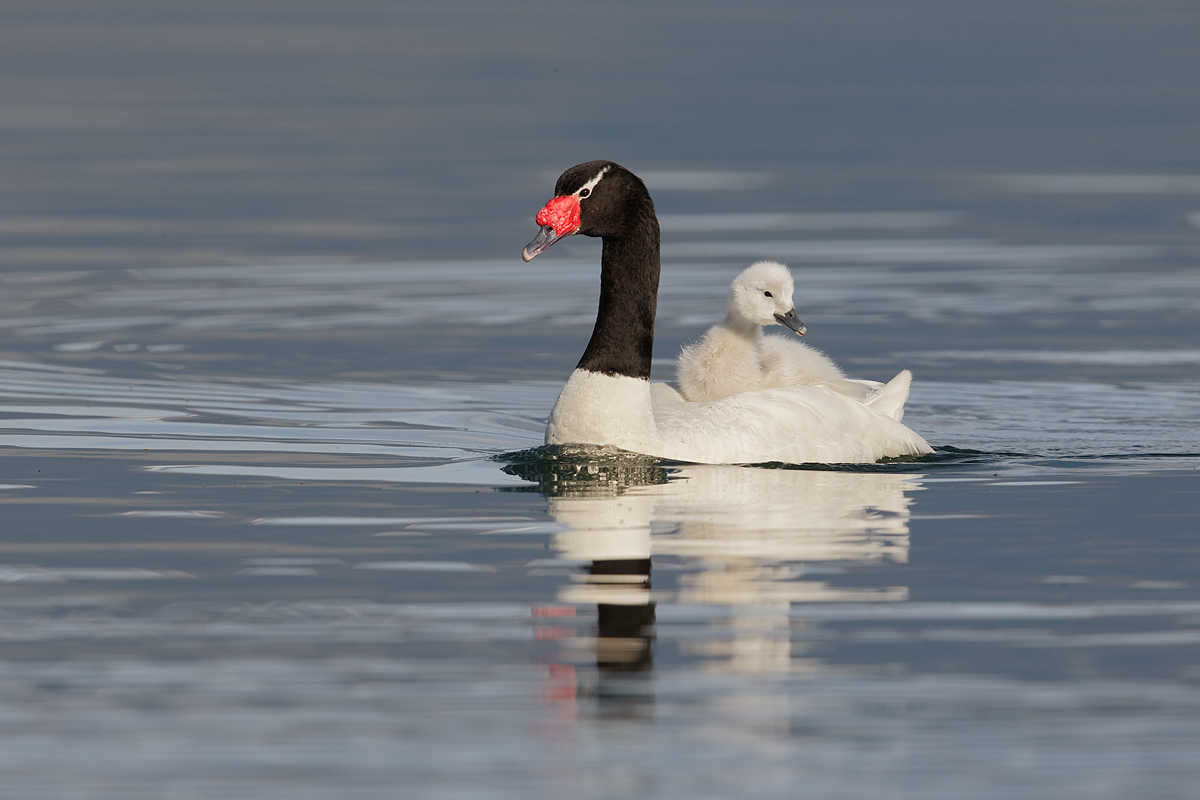
|
|
This adult Black-necked Swan with a cygnet on its back was photographed with the Gitzo 3532 LS carbon fiber tripod, the Mongoose M3.6 head, the Canon EF 600mm f/4L IS II USM lens, the Canon 2x EF Extender III (Teleconverter), and the Canon EOS-1D X. ISO 400. Evaluative metering +2/3 stop: 1/1000 sec. at f/10 in Manual mode. Central sensor (by necessity) Expand/AI Servo Rear Focus AF on the body of the middle bird active at the moment of exposure. Click on the image to see a larger version. |
Dealing With the Bright Whites
I should have been at 1/1250 sec. at f/10; I had not noticed that the light had gotten brighter as it got closer to 9:00am. I dealt with the relatively high contrast and the bright whites during the image optimization process. After dealing with the whites while converting the RAW file in DPP (see our DPP RAW Conversion Guide), I employed a variety of other techniques to restore detail in the whites. I used several NIK Color Efex Pro filters including Detail Extractor, Tonal Contrast, and White Neutralizer. I used a reverse S curve in Photoshop to reduce the contrast. And a small Linear Burn painted in with a Hide-All Layer Mask.
All of the above as described in detail in Digital Basics File, an instructional PDF that is sent via e-mail. It includes my complete digital workflow, dozens of great Photoshop tips including Digital Eye Doctor techniques, several different ways of expanding canvas, all of my time-saving Keyboard Shortcuts, Layer Masking and NIK Color Efex Pro basics, dealing with bright highlights, and tons more.
Your Favorite?
Please take a moment to leave a comment and let us know which of the four images is your favorite. And be sure to let us know why.
EOS-1D X Autofocus Guide
Until I get around to doing a complete user’s guide for the 1D X my 1D X Autofocus Guide will help you to master and get the most out of my all time favorite professional digital camera body. It includes my customized Case setting for photographing birds in flight and in action.
5D Mark III User’s Guide
EOS-5D Mark III User’s can learn to set up and use their cameras exactly as I do. Includes detailed advice on all menu and custom function items, AF suggestions, and all you need to know about creating great in-camera HDRs and Multiple Exposures.
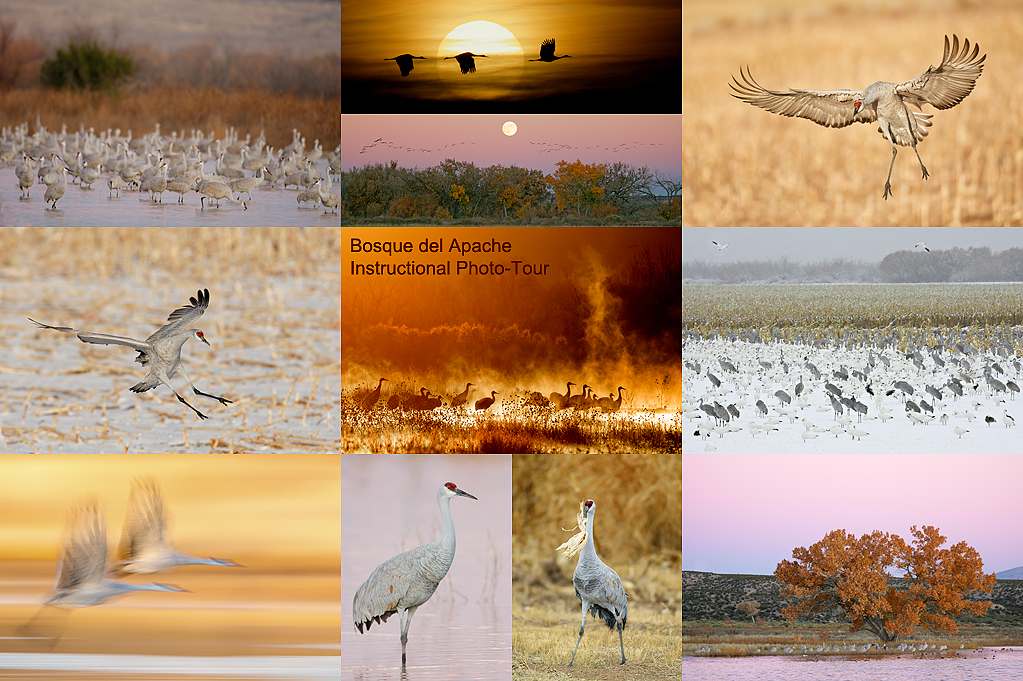
|
|
Bosque Sandhill Crane Composite; click on the image to enjoy a larger version. |
Bosque del Apache 2013 IPT: “The Complete Bosque Experience.” NOV 26-DEC 2, 2013. 7-FULL DAYS: $3399. Co-leader: Denise Ippolito. Introductory Slide program: 6:30 pm on 11/25. Limit: 12/Openings 8.
Please see the info on the short version of this IPT below if you will be spending Thanksgiving with your family.
Tens of thousand of Snow Geese, 10,000 Sandhill Cranes, ducks including point-blank American Wigeon and Wood Duck, amazing sunrises, sunsets, and blast-offs. Live, eat, and breathe photography with one of (if not the) world’s premier photographic educators at one of his very favorite locations on the planet. Top-notch Photoshop instruction. This will make 19 consecutive Novembers at Bosque for me. Nobody knows the place better than I do. Join us to learn to think like a pro, to recognize situations and to anticipate them based on the weather, especially the sky conditions, the light, and the wind direction. Every time we make a move we will let you know why. When you head home applying what you learned will prove to be invaluable. Includes all lunches and the Thanksgiving Buffet at the Crowne Plaza in Albuquerque. I hope that you can join me for what will be an unparalleled learning experience.
There is never a strict itinerary on a Bosque IPT as each day is tailored to the local conditions at the time and the weather. We are totally flexible in order to maximize both the photographic and learning opportunities. There is an introductory slide program on the night before the tour begins. We are up early each day leaving the hotel by 5:30 am to be in position for sunrise. After 18 years we pretty much know where to be when in what sky conditions and what winds. We usually photograph until about 10:30am. Then it is back to Socorro for lunch and then a classroom session with the group most days. We head back to the refuge at about 3:30pm each day and photograph until sunset. Then dinner with the group most nights. We always spend at least one afternoon at the ponds at the Albuquerque Zoo doing Wood Ducks and usually two mornings at New Mexico Tech doing American Wigeons. The rest is Snow Geese and Sandhill Cranes with the emphasis on expanding both your technical skills and your creativity.
A $500 non-refundable deposit is required to hold your slot for this IPT. Your balance, payable only by check, is due now. You will receive an e-mail notifying you of that after you place your deposit. If the trip fills, we will be glad to apply a credit applicable to a future IPT for the full amount less a $100 processing fee. If we do not receive your check for the balance on or before the due date we will try to fill your spot from the waiting list. If your spot is filled, you will lose your deposit. If not, you can secure your spot by paying your balance.
Please print, complete, and sign the form that is linked to here and shoot it to us along with your deposit check (made out to “Arthur Morris.”) You can also leave your deposit with a credit card by calling the office at 863-692-0906. If you register by phone, please print, complete and sign the form as noted above and either mail it to us or e-mail the scan. If you have any questions, please feel free to contact me via e-mail.
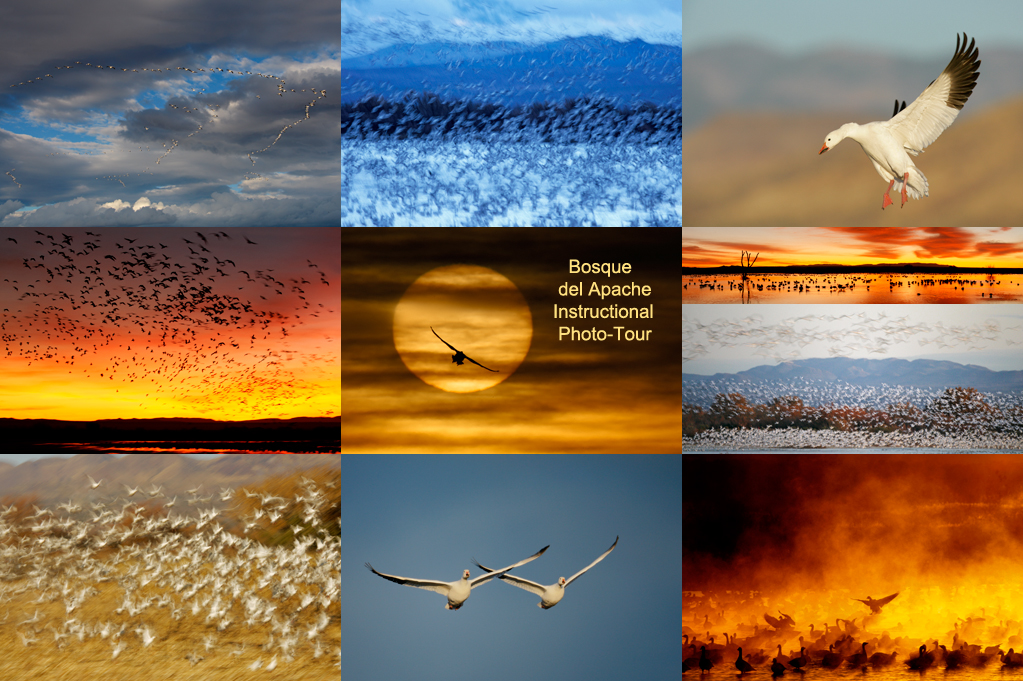
|
|
Bosque Snow Goose Composite; click on the image to enjoy a larger version. |
Bosque del Apache 2013 IPT: “The Short Version.” NOV 30-DEC 2, 2013. 3-FULL DAYS: $1199. Co-leader: Denise Ippolito. Introductory Slide program: 7:30 pm on 11/29. Limit: 12/Openings 4.
Tens of thousand of Snow Geese, 10,000 Sandhill Cranes, amazing sunrises, sunsets, and blast-offs. Top-notch Photoshop instruction. This will make 19 consecutive Novembers at Bosque for artie. Nobody knows the place better than he does. Join us to learn to think like a pro, to recognize situations and to anticipate them based on the weather, especially the sky conditions, the light, and the wind direction. Every time we make a move we will let you know why. When you head home applying what you learned will prove to be invaluable. Includes all lunches. I hope that you can join us for these three great days; they will offer a great learning experience.
There is never a strict itinerary on a Bosque IPT as each day is tailored to the local conditions at the time and the weather. We are totally flexible in order to maximize both the photographic and learning opportunities. There is an introductory slide program on the night before the tour begins. We are up early each day leaving the hotel by 5:30 am to be in position for sunrise. After 18 years we pretty much know where to be when in what sky conditions and what winds. We usually photograph until about 10:30am. Then it is back to Socorro for lunch and then an informal Photoshop/image review session with the group most days. We head back to the refuge at about 3:30pm each day and photograph until sunset. We may spend an afternoon at the ponds at the Albuquerque Zoo doing Wood Ducks and we may spend a late morning at New Mexico Tech doing American Wigeons. The rest is Snow Geese and Sandhill Cranes with the emphasis on expanding both your technical skills and your creativity.
A $500 non-refundable deposit is required to hold your slot for this IPT. Your balance, payable only by check, is due now. You will receive an e-mail notifying you of that after you place your deposit. If the trip fills, we will be glad to apply a credit applicable to a future IPT for the full amount less a $100 processing fee. If we do not receive your check for the balance on or before the due date we will try to fill your spot from the waiting list. If your spot is filled, you will lose your deposit. If not, you can secure your spot by paying your balance.
Please print, complete, and sign the form that is linked to here and shoot it to us along with your deposit check (made out to “Arthur Morris.”) You can also leave your deposit with a credit card by calling the office at 863-692-0906. If you register by phone, please print, complete and sign the form as noted above and either mail it to us or e-mail the scan. If you have any questions, please feel free to contact me via e-mail.
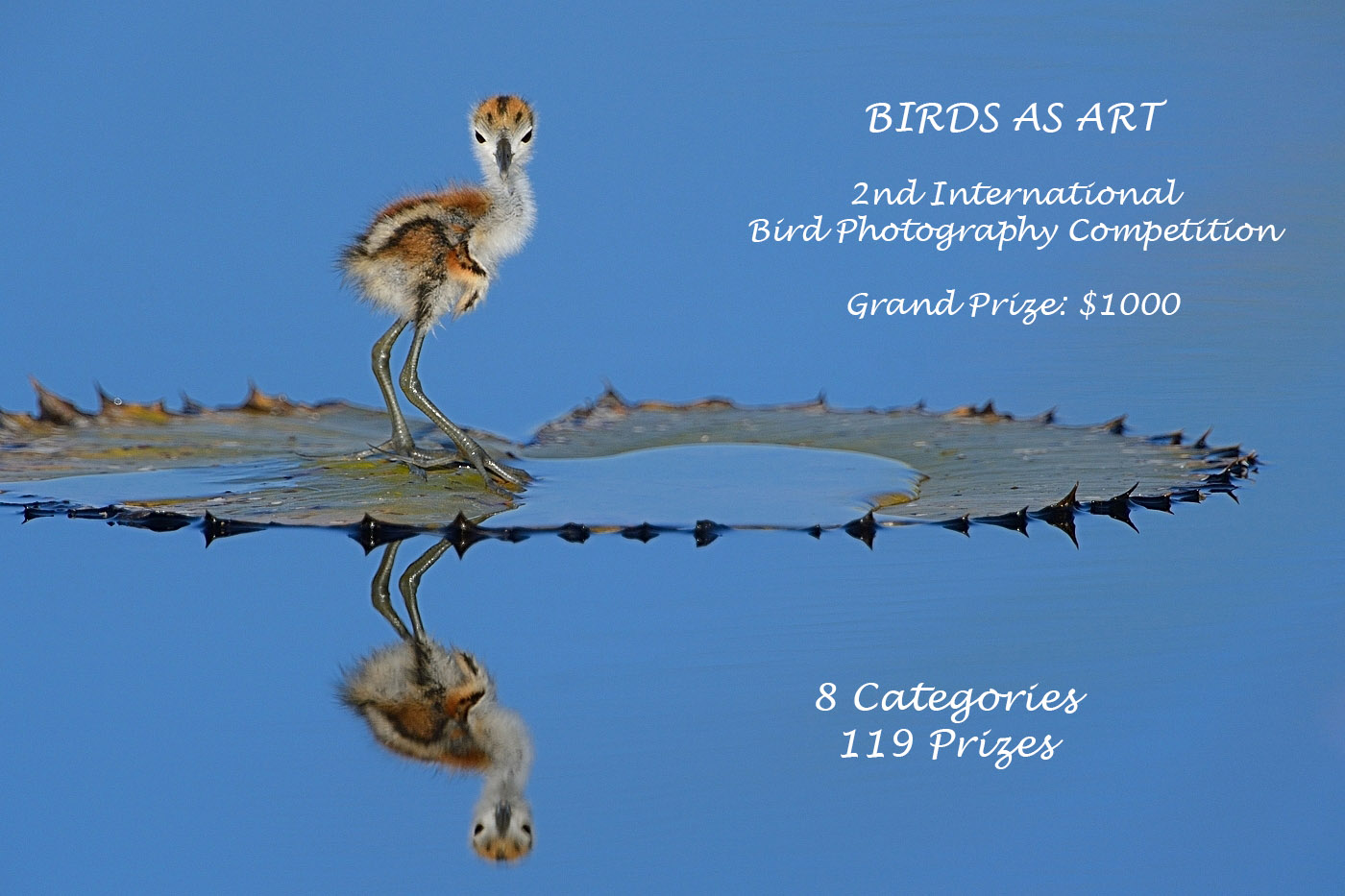
|
BIRDS AS ART 2nd International Bird Photography Competition
Learn more and enter the BIRDS AS ART 2nd International Bird Photography Competition here. Twenty-five great prizes including the $1000 Grand Prize and intense competition. Bring your best.
2014 Tanzania Summer Safari
If you are interested in joining us in Tanzania next summer please shoot me an e-mail and I will be glad to forward you the PDF with dates, itinerary, and price.
Support the BAA Blog. Support the BAA Bulletins: Shop B&H here!
We want and need to keep providing you with the latest free information, photography and Photoshop lessons, and all manner of related information. Show your appreciation by making your purchases immediately after clicking on any of our B&H or Amazon Affiliate links in this blog post. Remember, B&H ain’t just photography!




Amazon
Everyone buys something from Amazon, be it a big lens or deodorant. Support the blog by starting your search by starting your search by clicking on the logo-link below. No purchase is too small to be appreciated; they all add up. Why make it a habit? Because I make it a habit of bringing you new images and information on an almost daily basis.
Typos
In all Bulletins, feel free to e-mail or leave a comment regarding any typos, wrong words, misspellings, omissions, or grammatical errors. Just be right. 🙂
IPT Info
Many of our great trips are filling up. Two great leaders ensure that you will not learn more anywhere about how to make great images. Click here for the schedule and additional info.














No contest in my mind #4 wins out – interesting behavior -something a little different from the ordinary.
Off topic, but back to knees, as without them you can suffer getting into low photography positions… I had my knees (bone on bone) shot with Euflexa by my orthopedic Dr about a week before I went on a 3-day photography workshop and had great results. In fact, I can’t remember being more free of pain in a very long time! My physical trainer, however had just marginal good results. She is now using a Townsend knee brace in addition. Still, better results than doing nothing. Maybe worth checking out? (My Dr used to be the doc for many of the LA sports teams and has a very conservative approach to orthopedic problems: least invasive first. A good guy in my opinion.)
It’s a tight race between #1 and #4 but for me #1 wins.
I really like the clean light in #4 and the head positions. The cygnet has that smirk that says yes I’m clever, I’m getting a free ride. Very cute.
I’m not as crazy about the light in #1. The whites look a little dirty and not as crisp as #4. However, the swan is just too regal. The Velvety black neck, the perfect relaxed curve of the neck, and the confident arch of the back. This swan is at the top of its game and it knows it and so does anyone that sees it.
I love #4!!! BTW, did the Mongoose Gimbal head replace your Wimberly head??
Where have you beeN? I have been using the Mongoose exclusively with all of my big lenses for about 7 years. Just as efficient, I make sharp images at ridiculously slow shutter speeds, and most of all, it is much lighter–just what this old man needs. Why carry around an extra 2+ poounds?
My mistake I meant #4 of course.
I like #3 best. It is to me the most interesting of the three,
with the cygnet on the parents back, and a bonus with the head turn of the cygnet
Why add 1/3 stop? Because it is overall lighter in tone; no substantial black element.
No. 4, cute & a great bow-wave though I do like the intimacy of No. 2.
Good luck with the knee, it sounds horrible.
#4 without question. The relative position of the two heads could not be better.
No question, #4 is my favorite because of the subject matter.
Why add 1/3 stop? My TWAG (not a SWAG) is because you could. The adult has smoother feathers that might be more reflective, the cygnet’s fuzz is less reflective.